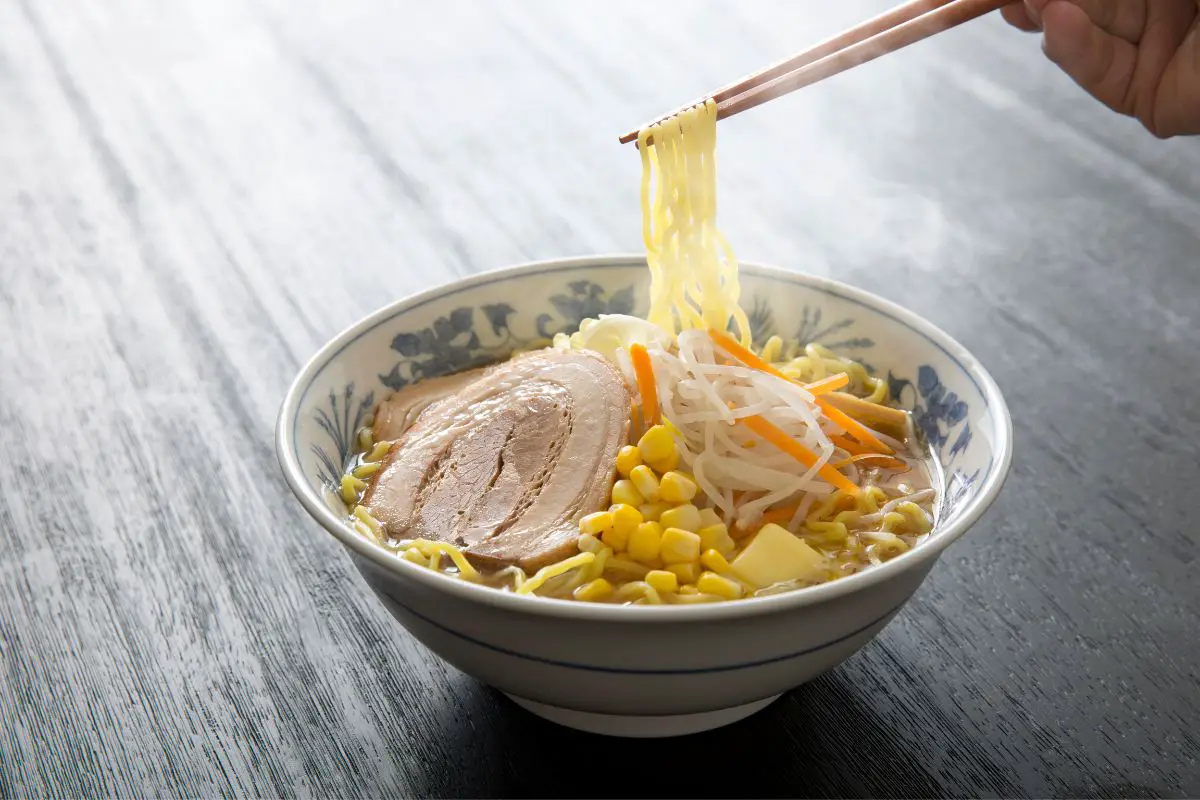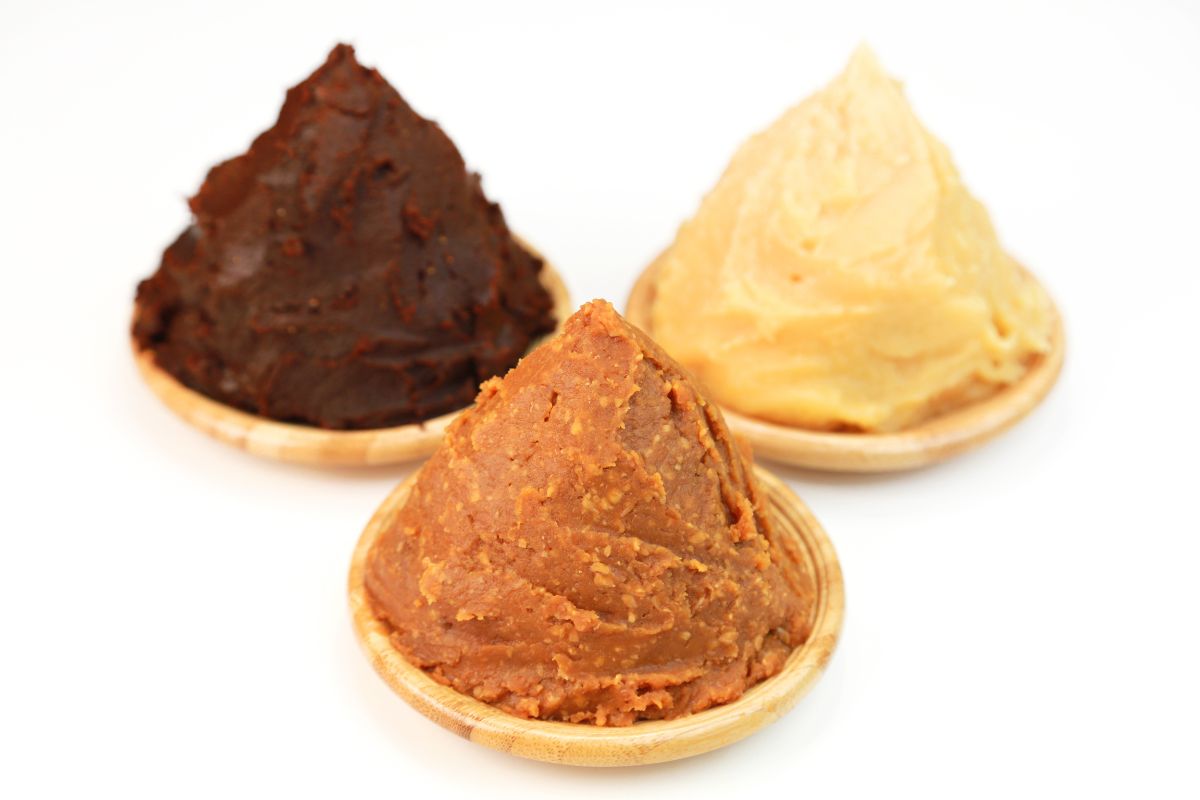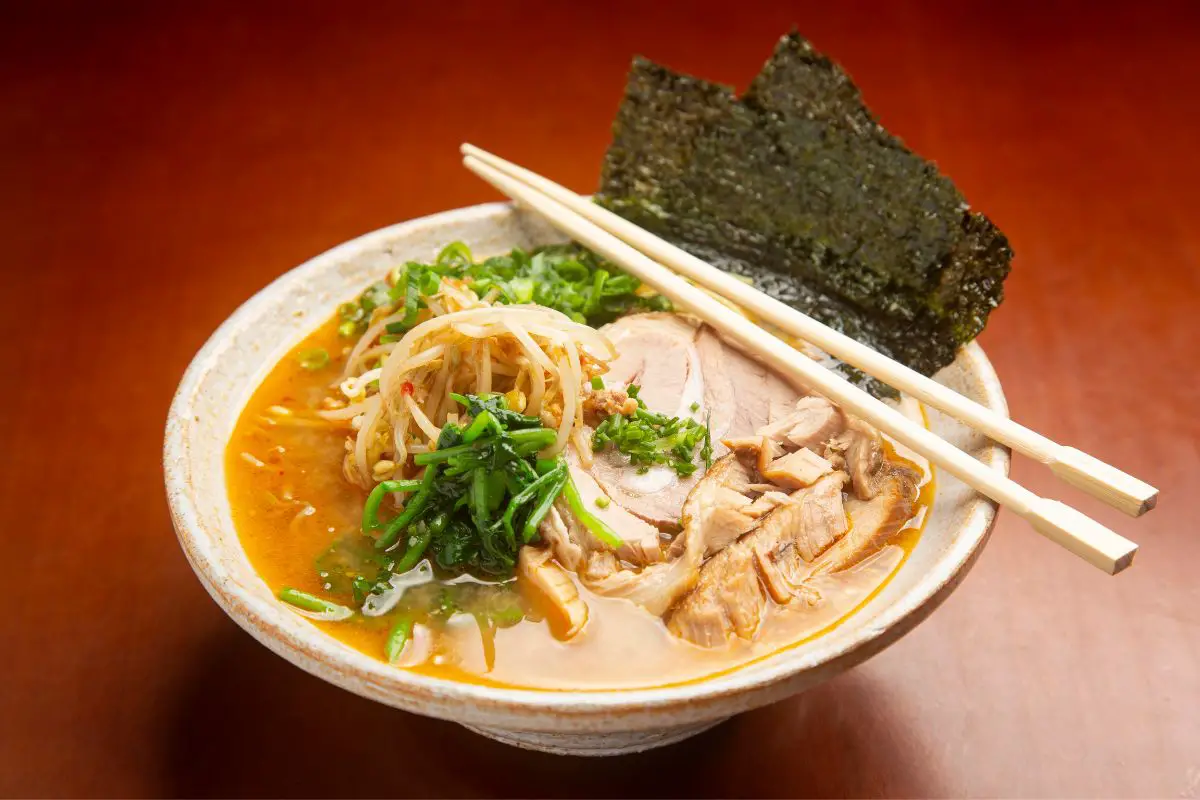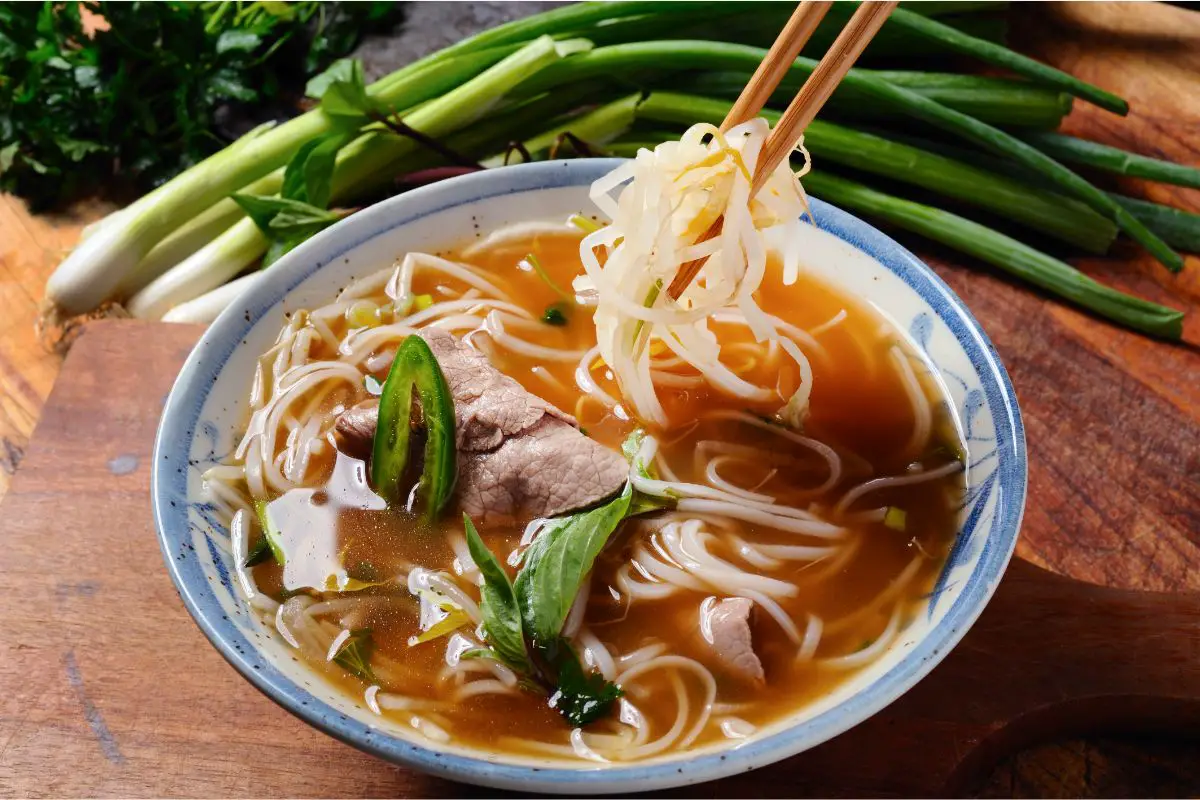If you’re a big fan of ramen, then you’ll know that cooking your own ramen at home can be slightly disappointing, and it often doesn’t taste as nice as the amazing ramen that you enjoy at your local restaurant.
However, with the help of this recipe, there’s absolutely no doubt that you’ll create the perfect miso ramen, and that’s not even the best part about it!

This ramen only takes 15 minutes to make, and whilst some purists will say that ramen should be simmered for hours before it’s eaten, however, with this recipe you simply won’t be able to taste the difference.
This recipe is also suitable for both vegetarians and vegans, which means that anyone can enjoy this warming ramen recipe.
So, for the perfect miso ramen recipe that is ready in 15 minutes, keep reading on!
What Is Miso Ramen?
Everyone who’s tried ramen will tell you how cozy this meal is, the combination of the noodles alongside the super warm broth is perfect, and you can even add a load of toppings on top if you want to change the way it tastes!
Whilst there is a wide variety of different ramen soup flavors out there, like coconut curry ramen, or kimchi ramen, today we’re going to be taking a closer look at the classic miso ramen soup recipe.
We know it might sound slightly basic, but we promise you that this ramen soup’s flavor will blow you away.
The most distinct part of this flavor is the umami flavor that runs throughout, and it’s also super creamy, salty and savory too, which is why ramen is loved by so many people all over the world!
However, you might be wondering, what exactly is miso ramen?
For those who might not know, miso ramen is a type of Japanese noodle soup that has been flavored with incredible miso paste.
Miso paste is a common ingredient in a lot of Japanese cooking, and is made from fermented soybeans, which is what helps to provide that distinctive umami flavor.
Alongside Shoyu (Soy) and Shio (Salt) seasoning, it’s one of the most common flavors of ramen soup.
For those who are looking to try and create a delicious ramen soup at home, miso is always recommended for that extra special taste.
Where Can You Buy Miso Paste?
So, if you’re wanting to give this recipe a try for yourself, then the first thing you’ll need to do is make sure that you can get your hands on some delicious miso paste, without it, your ramen soup is going to be lacking any flavor!
Thankfully, since miso paste has become increasingly popular in North America, it’s also become a lot easier to find, as it’s pretty common in your local health food stores, Asian grocery stores, or even chain grocery stores.
You’ll typically find miso paste in the refrigerated section of the grocery store.
What Are The Different Types Of Miso Paste?

So, when you come across miso paste in the grocery store, you might come across various types of miso paste, so how do you know which one you should pick for your ramen soup?
In most North American stores, miso paste will typically be color-coded, with the colors varying from white miso, to yellow miso, as well as red miso.
These types of miso in Japan have different names, known as Shiro miso, Shinshu miso, or Aka miso!
Let’s take a closer look at these different types of Miso!
White Miso – Shiro Miso
Typically light in color, white miso is the miso that has been fermented for the lowest amount of time, and therefore is the miso paste that has the mildest flavor, with only a slight hint of saltiness, and a distinctly sweet taste too!
This miso paste is best used as a salad dressing and marinades, as well as soups.
Yellow Miso – Shinshu Miso
As you might presume, yellow miso is fermented for longer than white miso is, which is why it has a much more acidic and saltier taste overall.
It is still rather mild however, and it’s great in soups, sauces, and marinades.
Red Miso – Aka Miso
Since red miso has been fermented the longest out of the three, as you can imagine, it has a much more punchy and strong flavor, and it’s a great way to really step up the intensity of the flavors in a range of dishes, such as stews and desserts, or even in some sauces.
Red miso is definitely a great ingredient to use in your dishes, but you need to make sure you use a lot less than you would use of white or yellow miso paste!
Which Miso Paste Should Be Used For Ramen?
So, when it comes to using miso paste for your ramen soup, which color miso paste should you be using in your ramen soups?
Ultimately, it depends on the level of intensity you want your ramen soup to have, however, we’d generally recommend sticking to using either white or yellow miso paste, which will provide your soups with all of the flavor you would want.
Red miso paste can still be used in lower quantities, but it’s easy for it to overwhelm the other flavors found in the dish, which will therefore ruin your soup altogether!
Miso Ramen Ingredients
So, let’s take a look at some of the ingredients that you’ll use in your miso ramen recipe!
- Ramen Noodles: Whether you choose to use fresh or dried ramen noodles in your miso ramen soup is entirely up to you, as both will work fine, so it’s down to what ramen you are able to get your hands on.
- Scallions: These are necessary if you want to ensure that your soup has plenty of flavor
- Ginger: Another great addition to your ramen soup is ginger, it’s a great way to really add a new level of depth to your soup. However, be careful not to add too much as it will overpower the soup.
- Garlic: It might be tempting to use garlic powder in this dish, however, fresh garlic is definitely what you should be using!
- Shiitake Mushrooms: When it comes to shiitake mushrooms in this dish, you can opt between dried or fresh shiitake mushrooms. Since this ramen soup is vegetarian, it’s the mushrooms that help to give it the rich flavor that is so commonly found in meat based ramen soups.
- Miso Paste: As previously mentioned, we’d recommend going with white miso paste for this recipe, (see also: Easy Recipe For Tuscan White Bean Soup (Healthy!))however if you want some slightly bolder flavors then you could also use some yellow miso paste instead.
- Tahini: A lot of people ask what the secret ingredient to make your ramen soup creamy is, and this is it, although if you are able to find Japanese sesame paste, you could also use that.
- Vegetable Broth/Stock: The broth or stock that you use in your soup is entirely up to you, so if you have a favorite vegetarian stock that you use on a regular basis, and are likely to keep in your pantry, then go ahead and use that!
- Soy Sauce: An essential ingredient in any form of ramen soup, if you need to opt for gluten-free soy sauce then you absolutely can. Or if you can’t find soy sauce but have tamari spare, you can use that to replace it.
- Chilli Paste: An optional addition to your ramen soup, you can always add chilli paste if you want your ramen soup to have a spicy kick to the broth, which is definitely welcomed on those colder days.
- Soft Tofu: Another optional choice of ingredient is soft tofu, which although might not add much in the way of flavor, helps by increasing the amount of protein you’ll be getting from the soup!
How To Make Miso Ramen

Now that we know what goes into our miso ramen soup, it’s time to begin making it!
Step 1
To begin, add a dash of oil (of your choice) into a pan on a medium to high heat, and add in the scallions and your garlic, and sautee them for 2 minutes.
Then you’ll want to add your ginger and your shiitake mushrooms and continue to saute the ingredients for an additional 3 minutes.
You’ll know when you’re ready for the next step when the mushrooms are beginning to brown.
Step 2
Once you’ve finished sauteing the initial ingredients, you’ll then want to add the miso paste, the tahini, and mix everything in the pan together.
Then you’ll need to add the soy sauce, vegetable stock, and if you want to, some chilli paste.
It’s also worth mentioning that if you don’t have any chilli paste to add, then you can always use dried chilli flakes or sriracha sauce instead!
Step 3
From here, you’ll want to bring the soup up to a light boil before adding your ramen noodles to the soup, your noodles should only be in the soup for 2-3 minutes until they go soft, but be sure not to overcook them!
Step 4
Once your noodles have cooked, you’re now ready to serve! Although if you want to add any toppings to your miso ramen soup, then now is the time, it all depends on your preference.
Suitable Toppings For Miso Ramen
As we mentioned, you can add any number of toppings to your miso ramen soup, and it’s what makes this dish so popular, since it’s so easy to customize to your own preferences.
Here’s a list of some of the toppings that we love to add to our miso ramen!
- Nori – which is dried seaweed.
- Jammy egg – just be warned that this will turn your otherwise vegan ramen dish into a vegetarian one.
- Sliced green onions
- Corn
- Spinach
- Bok Choy
- Bean Sprouts
- Kimchi
- Bamboo Shoots
- Pickled Ginger
- Sesame Oil
- Sesame Seeds
Frequently Asked Questions
We understand that for a lot of first timers, there are going to be a few questions surrounding their miso ramen, so we’ve covered the most frequently asked questions here so you don’t have to go searching for the answer!
Tips For Making Miso Ramen
Want to know the secrets to making perfect miso ramen? Check out these tips:
- Choosing the right miso paste: Make sure you’re using white or yellow miso paste, as red miso paste will ruin the taste of your soup!
- Gluten-Free: You can easily use gluten free noodles and gluten free soy sauce if you need your miso ramen to be gluten free.
- Adding the noodles: You should wait as close to serving as possible before you add in the noodles. The longer they sit in the soup, the soggier they will get, which means you’ll end up with less of that delicious broth too!
How Do I Store Miso Ramen?
If you have any leftover miso ramen, then just remember that you should always store the ramen noodles and the broth separate from one another, otherwise the noodles will become soggy from sitting in the broth for too long.
Simply remove the ramen from the soup, and store them both in an airtight container until you’re ready to eat them again!
How Do I Reheat Miso Ramen?
Reheating your leftover miso ramen is a simple process, just add the broth and the noodles to a pot on your stovetop and gently heat them up, or add them to a microwave safe bowl and reheat them in there.
How Long Will My Leftover Miso Ramen Last In The Fridge?
Unfortunately, your miso ramen won’t last forever in the fridge, even in an airtight container. Ideally you should eat all of your miso ramen when it’s freshly cooked, as this is when it will taste the best.
If you do have leftovers, you’ll be able to keep them for another 3 days in an airtight container in the fridge until you’re ready to eat them, but you should throw them out if they’re still there after 3 days.
Conclusion
Despite what you might see elsewhere, making the perfect miso ramen soup doesn’t need to take any longer than 15 minutes.
Which means that within 15 minutes, you can try out this incredible dish that is both filling and warming, and is completely customizable too!
So, if you’ve been thinking about trying out a miso ramen recipe sometime soon, then what are you waiting for? Use our recipe today!
- How To Make A Paleo Detox Smoothie: Berry Cherry Green Edition - April 18, 2023
- How To Make Spicy Paleo Paprika And Thyme Veggie Fries - April 18, 2023
- 15 Mouthwatering Keto Apple Recipes You Need To Try Today - April 18, 2023









